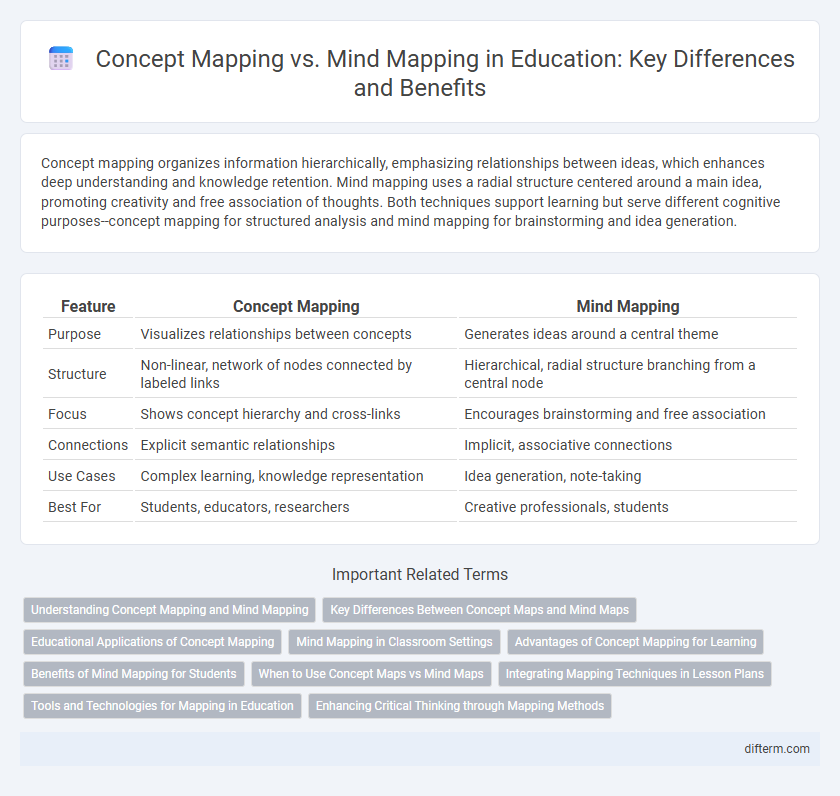Concept mapping organizes information hierarchically, emphasizing relationships between ideas, which enhances deep understanding and knowledge retention. Mind mapping uses a radial structure centered around a main idea, promoting creativity and free association of thoughts. Both techniques support learning but serve different cognitive purposes--concept mapping for structured analysis and mind mapping for brainstorming and idea generation.
Table of Comparison
| Feature | Concept Mapping | Mind Mapping |
|---|---|---|
| Purpose | Visualizes relationships between concepts | Generates ideas around a central theme |
| Structure | Non-linear, network of nodes connected by labeled links | Hierarchical, radial structure branching from a central node |
| Focus | Shows concept hierarchy and cross-links | Encourages brainstorming and free association |
| Connections | Explicit semantic relationships | Implicit, associative connections |
| Use Cases | Complex learning, knowledge representation | Idea generation, note-taking |
| Best For | Students, educators, researchers | Creative professionals, students |
Understanding Concept Mapping and Mind Mapping
Concept mapping organizes knowledge by linking concepts with labeled relationships, facilitating deep understanding of complex subjects through hierarchical structures. Mind mapping visually represents ideas branching from a central topic, promoting creativity and quick information recall. Both techniques enhance learning, but concept mapping emphasizes logical connections while mind mapping focuses on brainstorming and idea generation.
Key Differences Between Concept Maps and Mind Maps
Concept maps emphasize hierarchical relationships and structured connections between ideas, often using labeled links to show specific relationships, ideal for complex knowledge representation. Mind maps center on radial organization with a central idea branching out into related subtopics, promoting creativity and brainstorming through visual simplicity. Concept maps are used for critical understanding and detailed exploration, while mind maps support quick idea generation and memory retention.
Educational Applications of Concept Mapping
Concept mapping enhances educational understanding by visually organizing complex knowledge structures, highlighting relationships between concepts, and promoting meaningful learning through hierarchical frameworks. It supports critical thinking and problem-solving by enabling students to connect prior knowledge with new information, facilitating deeper comprehension and retention. Educators utilize concept mapping as an effective assessment and instructional tool to track student progress, stimulate collaborative learning, and tailor teaching strategies to individual cognitive needs.
Mind Mapping in Classroom Settings
Mind mapping enhances classroom learning by visually organizing information, promoting creativity, and improving memory retention for students. Unlike concept mapping, which emphasizes hierarchical relationships, mind mapping encourages free association and brainstorming, making it ideal for note-taking and idea generation. Educators leverage mind maps to foster active participation, clarify complex subjects, and support diverse learning styles.
Advantages of Concept Mapping for Learning
Concept mapping enhances learning by visually organizing complex information into hierarchical structures, facilitating deeper understanding and knowledge retention. It promotes critical thinking by illustrating relationships between concepts, helping learners integrate new information with prior knowledge. This method supports collaborative learning and problem-solving, making it a powerful tool in educational settings.
Benefits of Mind Mapping for Students
Mind mapping enhances students' learning by visually organizing information, which improves memory retention and comprehension. It encourages creativity and critical thinking by allowing students to connect ideas in a non-linear way. Mind maps also simplify complex subjects, making study sessions more efficient and engaging.
When to Use Concept Maps vs Mind Maps
Concept maps are ideal for organizing complex information by highlighting relationships between ideas, making them suitable for subjects requiring hierarchical understanding, such as science or history. Mind maps excel in brainstorming and generating ideas quickly, often used in creative writing or project planning where free association enhances ideation. Selecting between concept maps and mind maps depends on whether the goal is to analyze detailed connections or to foster expansive, nonlinear thinking.
Integrating Mapping Techniques in Lesson Plans
Integrating concept mapping and mind mapping in lesson plans enhances cognitive organization and deepens student understanding by visually connecting ideas and relationships within a topic. Concept maps emphasize hierarchical structure and cross-linking between concepts, fostering critical thinking and knowledge integration, while mind maps encourage creative brainstorming and flexible associations around a central theme. Using both mapping techniques strategically supports differentiated instruction and accommodates diverse learning styles, promoting active engagement and retention in educational settings.
Tools and Technologies for Mapping in Education
Concept mapping tools in education, such as CmapTools and MindMeister, offer structured diagram creation with predefined relationships, enhancing knowledge organization and assessment. Mind mapping technologies like XMind and FreeMind emphasize free-form visual thinking with flexible node connections, facilitating brainstorming and creativity in learning processes. Both tool types increasingly incorporate cloud collaboration, AI integration, and mobile accessibility, transforming interactive and personalized educational experiences.
Enhancing Critical Thinking through Mapping Methods
Concept mapping and mind mapping are powerful visual tools that enhance critical thinking by organizing and linking complex information systematically. Concept mapping emphasizes hierarchical relationships between ideas, promoting deeper understanding and analytical skills by revealing connections and patterns. Mind mapping fosters creativity and brainstorming by encouraging free association of ideas, which helps learners generate innovative solutions and explore diverse perspectives.
Concept mapping vs Mind mapping Infographic

 difterm.com
difterm.com